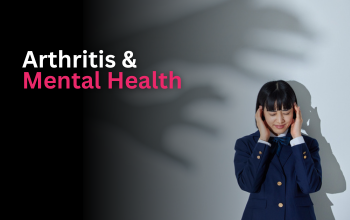The Arthritis Newsletter
Spring 2015Assessing Risk and Making Decisions
By Sheila Kerr and Linda Hirukawa
Dr. Nick Bansback makes a case for better patient understanding of risk in making health care decisions.
Methotrexate? Subsequent entry biologics? Triple therapy? Telling my boss about my disease? Anti-inflammatory creams or pills? High or low impact exercise or no exercise? Calorie reduced diet or the latest trend in dieting?
DECISIONS, DECISIONS, DECISIONS…
The health decisions we make can have a huge impact on our lives. With a move to patient-centred care, patients need to become better informed to make good shared decisions with their healthcare team. Can research identify how to best inform patients about their treatment options and how to support them in implementing these decisions?
Dr. Nick Bansback, who is a scientist at Arthritis Research Canada, is studying how we make decisions and how we can make better decisions for ourselves and for the healthcare economy. He is an Assistant Professor in the School of Population and Public Health at the University of British Columbia.
Dr. Bansback believes we are not always good at making decisions for better health outcomes or resource allocation.
Research has highlighted areas where we make poor decisions – such as some current medical practices that are ineffective, harmful and/or a waste of resources. Can you give us examples?
There are unfortunately many examples of medical practices that are both ineffective and harmful. For instance, imaging for low back pain – unless you have certain other symptoms, having an x-ray, CT or MRI scan will not provide your doctor any information about which treatment to pursue, but it will expose you to radiation. Yet 1000’s of such images happen each year, often because patients demand it from their doctors.
An organization called ‘Choosing Wisely’ is trying to address topics like this and has recently released a list of over 60 such medical practices. You can find out more at choosingwiselycanada.ca.
If we reduce the use of these ineffective treatments and tests, we can not only reduce harm to patients but also, reduce burden on the health care system, freeing up x-rays and scanners to patients who need them.
Dr. Bansback believes that good decisions require understanding and incorporation of risk. We need to understand each patient’s risk attitude and risk perception. Personal values, society and culture influence risk.
How would you define risk?
People take risks when they choose to do something that has a chance of a negative outcome. We typically make these choices because there is also a chance of experiencing something positive, but nearly all decisions in health also have negatives. Risks are typically described as probabilities, such as you have a 2% chance of a side effect from a given treatment. Unfortunately, understanding these probabilities and putting them in to context with risks we take everyday can be challenging for many people, including doctors trying to communicate them to patients. One of the reasons patients with low back pain think they should receive imaging is because they do not understand the risks of imaging and their lack of benefit.
And how would you characterize attitudes to risk?
A person’s approach to taking or avoiding risks is referred to as their attitude or aversion. These attitudes are personal, there is no right or wrong. Differences in these attitudes explain why some people make choices with high risk, and others do not. It is why some people choose new treatments with limited evidence on harms, and others refuse to use highly effective treatments with very small chances of side-effects.
What factors influence health risk attitudes? Are there gender differences?
Risk attitude is personal and you cannot tell by just looking at someone whether they are more or less averse to taking risks, but by observing behaviour in a large population you can start to see some patterns emerge. In general, women tend to be more risk averse than men, and as people get older the more averse to risk they tend to get. There is even a suggestion that shorter people may be more risk averse than taller people!
What level of risk is most commonly found in healthcare?
I recently conducted a survey in over 4000 Canadians which found nearly 80% of people are typically averse to health risks to different extents – so are generally cautious in the decisions they make. About 10% of people are risk takers and the rest are neutral. This is similar to other types of risks such as financial decision-making, where people tend to be quite conservative, but then there are a few who invest in highly volatile stocks. Interestingly there is not always overlap – some people appear to be averse to financial risks but more tolerant to health risks.
How do we, as patients, get help with understanding our risk and how it influences our decisions?
First, we can try to understand the magnitude and nature of a risk. The literature suggests that it is easiest to understand risks in terms of natural frequencies. Too often scientists present evidence in terms of relative risks or odds ratios – such as “a treatment doubles the risk of this side-effect”. But this isn’t very helpful if the underlying risk is small and might cause undue concerns (doubling a very small risk is still a very small risk!). In natural frequencies, you consider how many people out of 100 people would have the event with and without the treatment.
Second, to understand your attitude to risk requires you to think about your previous choices. Be careful about comparing yourself to others – there is no right or wrong, so friends or family may act very differently to you but that maybe since they have a different attitude to risk. There are questionnaires you can take that can help you understand your risk attitude compared to others.
We have entered an era of a more empowered patient and our relationships with our health care providers are changing. We want to make informed shared decisions based on our values, the latest research and the health care providers expertise.
As patients gain easy access to their health data, we need to have tools to help us add meaning to this information. We are not experts, and we cannot make sense of health research statistics or tell if a piece of research is of good quality. We don’t have an understanding of health care terms, so how do we best make sense of it all?
Most current health information does not describe risks very well – but there are moves to change this. The BC Ministry of Health recently made Patient-Centred Care a priority, following other provinces. Decision aids are one-way risk information might be improved, and they are increasingly being developed to help provide information on risks to patients. Decision aids help doctors describe all the options available to their patients, as well as the possible benefits and harms associated with each option in terms of natural frequencies. Some decision aids include examples of other patients’ experiences with different options. The goal is to help patients consider their options from a personal point of view so that they can reflect on how important different benefits and risks are to them.
Remember, while your doctor is the expert on the evidence and treatments, patients are the experts in knowing their personal attitudes. Decision aids can help doctors understand their patient’s attitudes. Research suggests that doctors often assume their patients have the same attitude to risk as themselves. This means patients can sometimes receive treatments or surgeries they would not choose if they were fully informed about their options and risks. This also explains why some patients choose not to adhere to medications prescribed to them by their doctors. There are lots of decision aids available – Ottawa has a repository, and Choosing Wisely has many good materials for example. Unfortunately, some decision aids are better than others, and not all doctors like to use them, but this seems to be changing.
What actions can patients take to make the best decisions in their personal circumstances?
My advice is to ask your doctor to help you understand the risks. Doctors should know where to get the most accurate and up-to-date numbers. It can be difficult to find risk information yourself and there is a lot of misinformation on the Internet. If you struggle to understand numbers, ask your doctor to describe the gist of the information.
Also, bring up your attitude to risk and explain to your doctor how you like to make decisions. Your doctor is in the best position to know the evidence and the options, but you are the expert on your own personal attitudes. The goal is to share this information and make a good decision together.
Dr. Bansback spoke with APAB members at a recent meeting about his plans for future research. He was seeking patient input starting right at the planning stage of his work, a great honour for patients engaged in research. We are being asked to help shape his research and to work to ensure user friendliness and uptake. That sounds like a good decision to us.
*Footnotes
Links to Decision Aids developed by researchers at Arthritis Research Canada in collaboration with people living with arthritis
-The ANSWER (the methotrexate decision aid) can be accessed at http://answer.arccanada.org/.
-Scientists are currently working on ANSWER2, a decision aid for people deciding whether or not to start on a biologic. If you are interested in testing this tool more information can be found here: https://answer-2.arthritisresearch.ca/index.php
Links to other decision aids
–Ottawa decision aid website: https://decisionaid.ohri.ca/AZsearch.php?criteria=arthritis
-Cochrane Musculoskeletal decision aid website: https://musculoskeletal.cochrane.org/decision-aids
Choosing Wisely website. http://www.choosingwiselycanada.org/materials/




















































